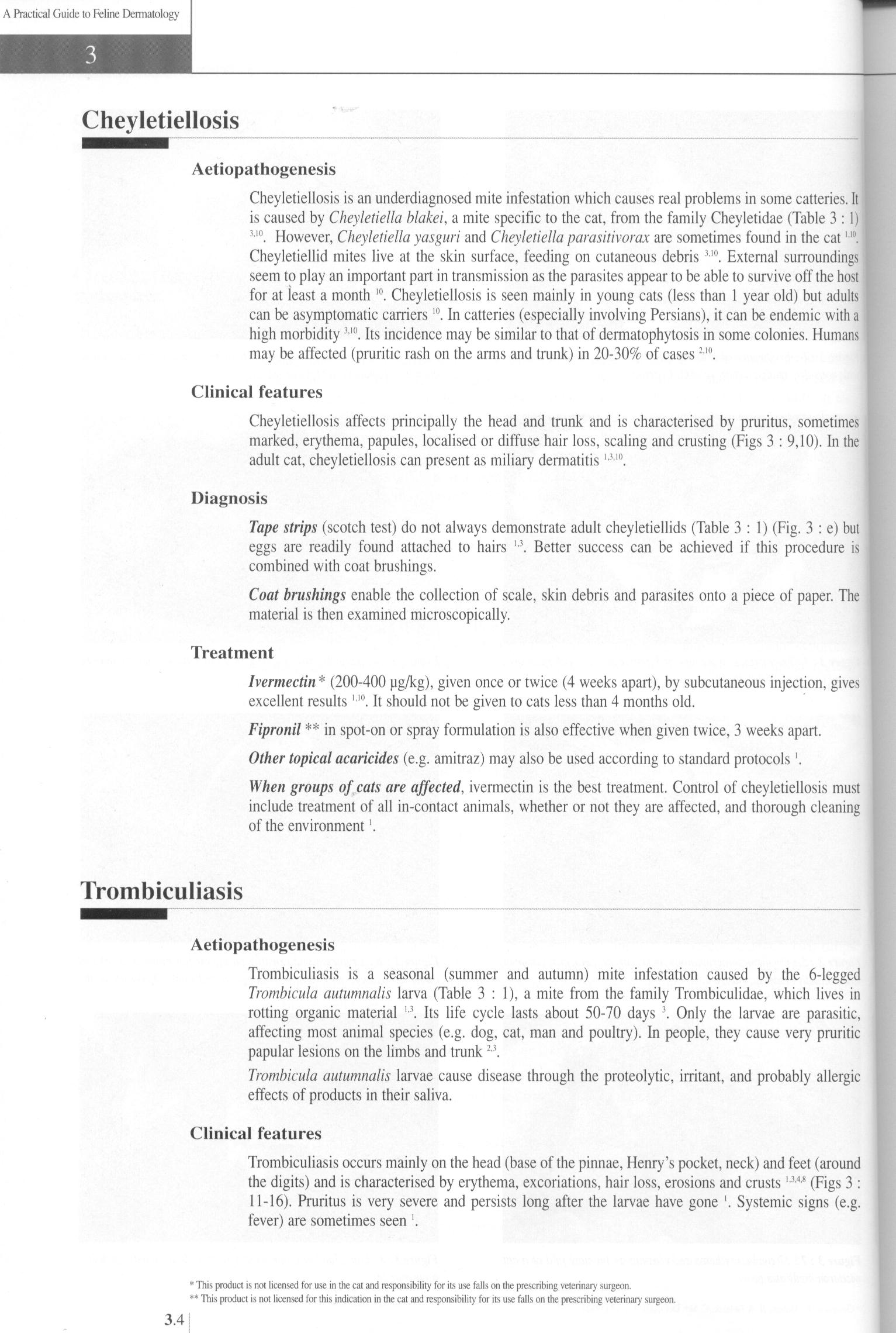33 (337)

3
A Practical Guide to Feline Dermatology
Cheyletiellosis
Aetiopathogenesis
Cheyletiellosis is an underdiagnosed mite infestation which causes real problems in some catteries. It is caused by Cheyletielła blakei, a mite specific to the cat, from the family Cheyletidae (Table 3 :1) 3,1°. However, Cheyletielła yasguri and Cheyletielła parasitivorax are sometimes found in the catu0. Cheyletiellid mites live at the skin surface, feeding on cutaneous debris310. Extemal surroundings seem to play an important part in transmission as the parasites appear to be able to survive off the host for at ieast a month l0. Cheyletiellosis is seen mainly in young cats (less than 1 year old) but adults can be asymptomatic carriersl0. In catteries (especially involving Persians), it can be endemic with a high morbidity 3,l°. Its incidence may be similar to that of dermatophytosis in some colonies. Humans may be affected (pruritic rash on the arms and trunk) in 20-30% of cases 2,1°.
Clinical features
Cheyletiellosis affects principally the head and trunk and is characterised by pruritus, sometimes marked, erythema, papules, localised or diffuse hair loss, scaling and crusting (Figs 3 : 9,10). In the adult cat, cheyletiellosis can present as miliary dermatitis13’10.
Diagnosis
Tape strips (scotch test) do not always demonstrate adult cheyletiellids (Table 3:1) (Fig. 3 : e) but eggs are readily found attached to hairs u. Better success can be achieved if this procedurę is combined with coat brushings.
Coat brushings enable the collection of scalę, skin debris and parasites onto a piece of paper. The materiał is then examined microscopically.
Treatment
hermectin * (200-400 pg/kg), given once or twice (4 weeks apart), by subcutaneous injection, gives excellent results uo. It should not be given to cats less than 4 months old.
Fipronil ** in spot-on or spray formulation is also effective when given twice, 3 weeks apart.
Other topical acaricides (e.g. amitraz) may also be used according to standard protocols'.
When groups of cats are affected, ivermectin is the best treatment. Control of cheyletiellosis must include treatment of all in-contact animals, whether or not they are affected, and thorough cleaning of the environment'.
Trombiculiasis
Aetiopathogenesis
Trombiculiasis is a seasonal (summer and autumn) mite infestation caused by the 6-legged Trombicula autumnalis larva (Table 3 : 1), a mite from the family Trombiculidae, which lives in rotting organie materiał M. Its life cycle lasts about 50-70 days 3. Only the larvae are parasitic, affecting most animal species (e.g. dog, cat, man and poultry). In people, they cause very pruritic papular lesions on the limbs and trunk23.
Trombicula autumnalis larvae cause disease through the proteolytic, irritant, and probably allergic effects of products in their saliva.
Clinical features
Trombiculiasis occurs mainly on the head (base of the pinnae, Henry’s pocket, neck) and feet (around the digits) and is characterised by erythema, excoriations, hair loss, erosions and crusts1,3A8 (Figs 3 : 11-16). Pruritus is very severe and persists long after the larvae have gone '. Systemie signs (e.g. fever) are sometimes seen '.
* This product is not licensed for use in the cat and responsibility for its use falls on the prescribing veterinary surgeon.
** This product is not licensed for this indication in the cat and responsibility for its use falls on the prescribing veterinary surgeon.
3.4 j
Wyszukiwarka
Podobne podstrony:
222 (33) 22 A Practical Guide to Feline Dermatology AnimaTs way of life and environment: cats that l
67 (125) 6 A Practical Guide to Feline DermatologyNocardiosisAetiopathogenesis Nocardiosis is a very
510 (5) A Practical Guide to Feline DermatologyCoccidioidomycosisAetiopathogenesis Coccidioidomycosi
252 (18) 25 A Practical Guide to Feline DermatologySporotrichosis Sporotrichosis is a deep mycosis,
58 (148) 5 A Practical Guide to Feline Dermatology severity of the illness. High titres are seen wit
65 (127) 6 A Practical Guide to Feline Dermatology Other topical antimicrobial agents, such as chlor
69 (119) 6 A Practical Guide to Feline DermatologyDiagnosis The diagnosis is based on lesion distrib
710 (2) 7 A Practical Guide to Feline DermatologyHerpesvirus infections Dermatological manifestation
74 (105) 7 A Practical Guide to Feline Dermatology ulcerated. Lesion distribution is multicentric bu
27 A Practical Guide to Feline Dermatology Perianal glands 1.7 Permethrin 3.12, 3.13 Persian 1.6,2.2
27 A Practical Guide to Feline Dermatology Stemphyllium spp. 5.1,7.8 Stereotypie behaviour 17.1,
272 (16) 27 A Practical Guide to Feline Dermatology Alternaria spp. 5.1,7.8 Aluminium hyroxide 15.6&
274 (18) 27 A Practical Guide to Feline Dermatology Colitis 11.2 Collagen 1.2,2.6,12.1,
278 (17) 27 A Practical Guide to Feline Dermatology I J Histoplasmosis 5.8, 7.8, 25.2 Homer’s syndro
28 (374) 2 A Practical Guide to Feline Dermatology Configuration of lesions Determining the configur
313 (14) A Practical Guide to Feline Dermatology The second phase consists of long-term control of t
31 (328) 3 A Practical Guide to Feline Dermatology Sarcoptic mange Sarcoptes scabiei var canis (Tabl
82 (128) 8 A Practical Guide to Feline Dermatology considered important parasites. Cats in the Unite
42 (226) 4 A Practical Guide to Feline Dermatology Increased hydration and subsequent maceration of
więcej podobnych podstron